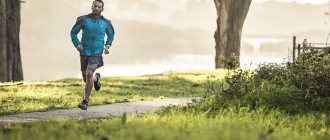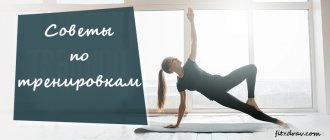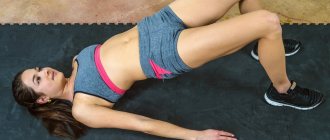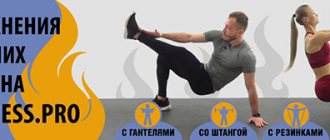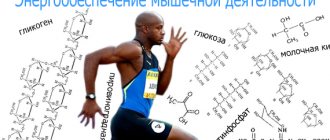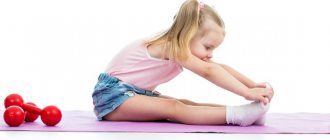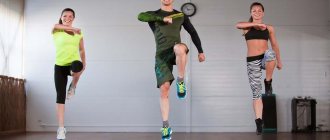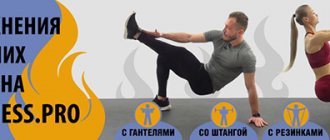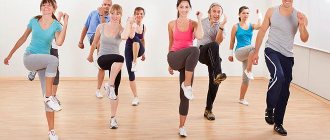Recommendations and tips in studying flexibility as physical education ( 1 votes, average: 5.00 out of 5)
Flexibility as a physical quality is very important for every person, because it is an indicator of the health and youth of the body. If you decide to improve your stretching level, we provide tools and methods for developing flexibility for beginners. The main thing is to practice more and then you will be able to reach maximum heights.
Development of flexibility, endurance as physical qualities
However, people who want to start doing exercises to develop flexibility are faced with a whole series of questions:
- What does developed flexibility give a person?
- How to start developing it correctly?
- What's the best time to workout?
Today we will try to answer all these questions.
Flexibility and its benefits for the whole body
Flexibility as a physical quality has a positive effect on the functioning of many body functions: improves blood circulation and supply of tissues with nutrients and pure oxygen, increases joint mobility, and strengthens the body. Over the years, this quality gradually declines if a person does not take measures to develop it through exercise. Developed flexibility protects the body from various chronic diseases, bones, joints and muscles.
Flexibility and its benefits for the whole body
Flexibility exercises are also great for stabilizing and strengthening body tissues after a hard workout. After strength training, a person’s muscles are very tense due to frequent contractions, thus our body reacts to the training for a long time, maintaining the tissues in working condition. The recovery process is delayed, and to avoid this, perform a short complex to develop flexibility.
If a person ignores stretching exercises, then over time he will lose flexibility, his movements will be constrained and awkward. Tight muscles certainly do not contribute to the development of strength and endurance, and as a result, strength training loses its effectiveness.
Types of endurance
There are a huge number of disciplines where endurance plays an important role in achieving results. A marathon runner and a weightlifter have a fairly developed quality, but the specifics of the exercises they perform are completely different. This suggests that there are several types of endurance that are responsible for different muscle groups and different activities.
Depending on the type of activity, general and special types of endurance are distinguished.
General endurance is considered to be the physical capabilities of the body aimed at performing a nonspecific type of activity. The intensity of the exercise is at a normal level, mainly large and medium muscle groups are involved. This type determines the level of general performance in sports and professional activities.
This type of endurance is directly related to the aerobic power of the body, that is, the body’s ability to work in comfortable conditions without the formation of an oxygen debt and the inclusion of small muscle groups in the work.
The development of general endurance is comprehensive. This complex word hides the indirect development of a result in another activity.
If, as a result of regular running, it was possible to increase the level of aerobic power, then the improvement in this quality will affect other aerobic exercises. That is, with the help of running you can indirectly influence the result in swimming, since general endurance does not have a specific focus.
Special endurance is aimed at performing long-term specific loads that are characteristic of a particular sport or profession. This type of endurance is characterized by anaerobic work, that is, performing an exercise for a long time with the formation of an oxygen debt.
Special endurance is a more complex physical quality because it forces small muscle groups to work. Performing such work requires training motor skills and good coordination, as well as the right mental attitude.
It is the special resistance of the body that is the difference between athletics and weightlifting endurance.
It is called special because of the specific skills and abilities that are characteristic of a certain type of activity during work or physical exercise. For example, short-distance running and ultramarathoning have well-developed special endurance, but each has a different set of skills and abilities, as well as different development of large, medium and small muscle groups. As well as different degrees of development of aerobic and anaerobic power.
Drawing a parallel between general and special endurance, it can be noted that special, unlike general, does not provide an additional effect when performing other types of activities. Remember that by training aerobic power by running, we can indirectly influence the result in swimming. So, in the case of special endurance, such a technique has a weak effect or is absent altogether. Special endurance training leads to the development of qualities characteristic of a particular discipline: running, jumping, throwing, pushing.
Therefore, special endurance is divided into several separate types:
- Express
- Speed-strength
- Coordination
- Power. In turn, strength endurance is further divided into dynamic and static.
Speed is characterized by a person’s ability to perform fast movements for a long time without fatigue or disruption of technique. Develops with the specified focus of exercises. For example, performing accelerations.
Speed-strength has a similar definition as speed endurance. There is only a slight difference. Speed-strength ability is characterized by the performance of actions of a high activity of a power nature for a long time. That is, if speed endurance is performing fast movements, then speed-strength endurance is the same, only performing strength exercises.
Coordination endurance manifests itself through repeated repetition of complex technical and tactical actions. It is especially evident in sports games and gymnastic exercises. In running it is less important, since the nature of the movements is predominantly cyclical.
Strength endurance refers to the muscular ability to perform heavy exercise for long periods of time without visible technical impairment. This type of endurance shows the ability of muscles to contract again after a minimum period of time.
- Dynamic strength endurance is characterized by performing heavy muscle exercises at a relatively slow pace, but for a fairly long time.
- Static endurance allows you to maintain muscle tension for a fairly long period without changing your posture. Usually only certain muscle groups work, and the higher the degree of tension, the shorter the duration of the exercise.
When addressing the issue of types of endurance, quite a lot of attention was paid to the aerobic and anaerobic power of the body.
Types of flexibility in physical culture
Stretching exercises come in two types: passive and active. The former are recommended for beginners, the latter are designed for professional athletes.
Types of flexibility in physical culture
Passive stretching
This method of developing flexibility is intended for beginners, which consists of gently and gently stretching the muscles in a certain position for twenty seconds. Less time is unacceptable, as the fabric will not have time to stretch.
Active stretching
Exercises to develop this type of flexibility are performed only by professional athletes who have some experience and the proper level of physical fitness. Such complexes are not suitable for beginners, since many movements are performed dynamically and actively, which can lead to injuries in a person with undeveloped flexibility.
https://youtu.be/RCqkZ_5FrSw
Flexibility as a physical quality is given to a person by birthright, but over time it needs to be developed and worked on.
Principles of force specificity
To achieve each specific goal, it is necessary to adhere to a certain power strategy. While moving a very heavy weight at a slow pace will produce one kind of force, moving a light weight at a fast pace will produce a completely different kind of force. For example, to train for maximum strength, you need to work in a very low rep range with very heavy weights, while to develop explosive strength, you need to lift moderate weights at a very fast pace.
Below we will present 7 types of strength, and you will determine which one is suitable for your goal in a given period of time.
Recommendations and advice in studying flexibility as physical education
- Fix in each position for 10-30 seconds.
- Breathing should be slow and deep throughout the workout.
- Sudden movements and swaying while performing a passive form of stretching are unacceptable.
Recommendations and advice in studying flexibility as physical education
- Clothes should not constrain or interfere with movements; give preference only to natural materials.
- Before performing the complex, do a warm-up to protect yourself from injury and prepare your body for stress.
- While performing this or that exercise, concentrate your attention on the areas of the body involved in the work.
- Avoid sharp and stabbing pain; these sensations indicate that you are performing the movement incorrectly.
- Flexibility as a physical quality is developed through regular training. Beginners should exercise at least three times a week.
- Study this topic comprehensively, read articles, watch video lessons.
- Keep the number of breaks between exercises to a minimum.
Relative strength
The amount of force per 1 kg of an athlete’s weight is called relative. If neuromuscular coupling and maximal strength increase while the athlete's body weight remains the same, relative strength increases.
Example : 2 athletes with the same weight perform a deadlift. The first lifts 220 kg, and the second lifts 235 kg. Since the second athlete is able to produce more force per 1 kg of his body weight, his relative strength is higher than that of the first athlete.
Benefits of Developing Relative Strength:
o Increased intramuscular coordination.
o Improved neuromuscular communication.
o Increased functionality in different sports.
How to train:
Relative strength can be increased by using any of the presented strength styles. An indicator of its growth is the progression in working weights while maintaining or reducing the athlete’s weight.
Exercises to develop flexibility and endurance
- Stand up straight and take a wide lunge with your left leg, bending your knee 90 degrees. The thigh should be parallel to the floor. The right leg is straightened and the toe rests on the floor. Tighten the muscles of your back leg by pressing down on your foot as much as possible. This exercise helps stretch the calf muscles.
- Squat down a little on your right leg, stretch your left leg forward, toes pointing towards you. The second version of this exercise is more effective.
Sitting on the floor, place one leg under you, bending it at the knee, straighten the other forward. With a straight back, slowly bend forward and try to reach your feet with your hands. Deepen the incline until your stomach, chest, and face are all the way down onto your leg.
Exercises to develop flexibility and endurance
Stay in this position for several breaths or 20 seconds, change legs and repeat the sequence of movements. Regular performance of this exercise develops the flexibility of the biceps femoris muscles and gluteal tissue.
- Stand straight and, bending one leg at the knee, lift it back towards your buttocks. Grab your foot with your hand and gently pull it towards you, stretching the hamstrings and tendons.
- Stand straight, place your feet shoulder-width apart. Raise your left hand up, press your right hand to your thigh. Bend your body to the right side, your right hand sliding along the reed. Lock in this position for 5 seconds and return to the starting position. Swap your hands and perform a similar bend in the other direction.
- The body position is similar to the previous exercise. Raise both arms up and tilt your body back with your arms straight behind your head. Next, lean forward, trying to reach your toes or the floor with your hands. If you succeed, then deepen the tilt until your stomach, chest and face completely rest on your legs. Hold in the final position for 20 seconds.
Functional strength
Functional strength refers to the ability to generate and control forces in the context of daily living.
While traditional strength training is aimed at producing muscle contractions in order to move weight along a clear path in one plane, in everyday life there is a constant need to move something heavy in several planes at once.
Roughly speaking, if you need to carry bags of cement, then train your ability to carry heavy bags.
Examples : lifting and carrying a child, a bag or a refrigerator.
Benefits of Developing Functional Strength:
o Improving the elasticity of muscles and connective tissue.
o Reducing the risk of pulling a muscle and getting a sprain.
o Increased functionality in different sports.
o Improved performance in everyday activities.
How to train:
To develop functional strength, it is necessary to use movements that allow you to move weight in different planes. Choose exercises using dumbbells, sandbags, medicine balls and cable machines.
Intensity: Low to moderate, at 50-75% of 1RM (repetition maximum) for each individual exercise.
Number of repetitions: 12-15+
Tempo: variable, from slow to fast.
Sets: 2-5+
Rest: 30-90 seconds.
Speed Force
Speed strength is trained through efforts that the muscles are capable of producing at the highest possible speed.
Examples : sprinting, throwing a baseball.
Advantages:
o Improved response.
o Improved athletic performance.
o Reducing the time between muscle relaxation and contraction.
How to train:
Perform multi-joint exercises using your own body weight or a minimal set of equipment in a maximum speed style.
Intensity : low to moderate, at 30-50% of 1RM.
Repetitions: 1-6
Tempo : fast, explosive.
Sets: 2-6+
Rest : from 30 seconds to 2 minutes.
